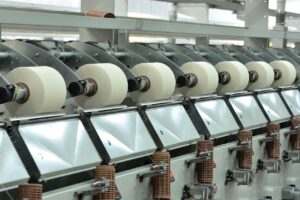What is Difference Between Ring Spun, Open End and Autocoro Yarn

Difference Ring Open End and Auto Coro
Ring Spun
This yarn is a better-quality yarn with higher prices and higher cost of production as compared to open end or Autocoro yarns.
Ring spun yarn factory consists of the following manufacturing processes.
1. Blow Room.
2. Carding.
3. Drawing.
4. Combers or Combing process.
5. Simplex
6. Ring
7. Winding or Auto cone department
Above is the complete spinning or yarn manufacturing process engaged in the ring spun yarn production.
The rotor machine takes over all the work after the Drawing process in both the open end and Autocoro, reducing production costs. However, the high draft applied by the rotor machine compromises the yarn’s quality. This factor also affects the quality of yarns. In ring we have wide range of options for yarn counts but in open end or autocoro we can produce limited number of yarn counts.
Following are processes in open end or autocoro yarn manufacturing.
1. Blow Room.
2. Carding.
3. Drawing
4. Rotor machines.
What is the difference between Open End and Autocoro Yarns.
There is no major difference between open end and autocoro yarns. The primary difference stems from their production methods: Auto Coro yarn is manufactured with advanced machinery using a consistent manufacturing system, whereas open-end yarn is fashioned using older open-end machines.
Open End
Open End machine is the older version of machines. It can mostly not produce finer or higher number of counts above 20/1 oe although We can produce up to 30/1 on open end machines but we have to decrease the machine speed which decrease the production and increase the production cost. It mostly produces coarser counts ranging from 6/1 oe to 16/1 oe or 20/1 oe.
Auto Coro is the latest machine having the ability to produce yarns of fine quality with higher speed. its count range is also higher and its drafting system allow you to produce yarn counts up to 60/1 although mainly people prefer to produce yarn counts till 40/1. Autocoro production capacity is also very high as compare with open end machine.
Hope you have under stood the difference in open end and auto coro yarns. In case of any confusion please drop your question in below comments section.
What is difference between Carded and Combed Yarn
Carding is the initial step in the spinning process, where every spun yarn begins as cotton is cleaned using a carding machine. The purpose of carding process is to clean the cotton from trash, leaf and other foreign matters. This process cleaned the cotton and straighten the fibers and converted the cotton into sliver. This process transforms the sliver into the final form of yarn. Another method involves enhancing yarn fineness through the combing process. Cotton subjected to this process undergoes thorough cleaning, removing damaged, entangled, and floating fibers. Combing achieves an additional 15% to 20% cleanliness of the cotton. The combed yarn is much better in quality as compared with carded yarns.
Manufacturers use combed yarn to create more reliable and finer quality fabrics in both knitting and weaving. This yarn also commands a higher price compared to carded yarn due to the extraction of more waste from the cotton, thereby increasing the cost of yarn production. Combed yarn run smoothly of fabric manufacturing machines than the carded yarn.
Hope you have now understood the difference between carded yarn and combed yarn. if need further clarification about which is better yarn in carded and combed yarn, please drop your question in comment section. We would be happy to answer you and help you in solving your problems.
Frequently Asked Questions
Absolutely, here’s a concise FAQ detailing the differences between Ring Spun, Open-End, and Auto Coro yarns in the textile industry:
What are Ring Spun, Open-End, and Auto Coro yarns?
- Ring Spun yarn: In the traditional ring spinning method used to create this yarn, fibers are twisted and drawn into yarn on a ring spinning frame. This method is renowned for yielding yarn with notable strength, softness, and versatility.
- Open-End yarn: Open-End spinning involves a high-speed process where fibers are twisted together using a rotor instead of a traditional ring spinning frame. It’s a cost-effective method suitable for producing bulkier yarns.
- Auto Coro yarn: Automated rotor spinning machines are utilized to produce Auto Coro yarns, equipped with advanced functionalities for automatic doffing and winding onto packages. It combines elements of both ring spinning and open-end spinning.
How are they produced differently?
- Ring Spun yarn: Fibers are drawn, twisted, and wound into yarn using a ring spinning frame. It’s a slower process but produces high-quality, fine-count yarns.
- Open-End yarn: A rotor spinning machine swiftly spins and twists fibers together at high speeds, enabling the rapid production of coarser yarn counts.
- Auto Coro yarn: It undergoes an automated process akin to open-end spinning, yet it incorporates added features for automatic winding and enhanced quality control.
What are their characteristics?
- Ring Spun yarn: Known for its strength, smoothness, and ability to produce finer and more consistent yarns suitable for high-quality fabrics.
- Open-End yarn: Cost-effective, suitable for bulkier yarns, and often used in denim, towels, and other applications where a textured yarn is desirable.
- Auto Coro yarn: Combines aspects of both ring spinning and open-end spinning, offering improved quality control and productivity compared to traditional open-end spinning.
What are their applications?
- Ring Spun yarn: Commonly used in fine fabrics, high-quality clothing, bedding, and textiles where a smooth finish and strength are essential.
- Open-End yarn: This type of yarn finds frequent application in the production of denim, towels, rugs, and other items that benefit from a coarser or textured yarn.
- Auto Coro yarn: Used in various applications including finer fabrics, apparel, home textiles, and technical textiles due to its balance of productivity and quality.
Which one is more cost-effective?
- Ring Spun yarn: While it produces high-quality yarn, it’s relatively slower and can be more expensive due to the intricate spinning process.
- Open-End yarn: Known for its cost-effectiveness in producing bulkier yarns at higher speeds, making it suitable for specific applications.
- Auto Coro yarn: Offers improved productivity and quality compared to traditional open-end spinning, making it a potentially cost-effective option for finer counts.
Understanding the differences between these yarn types helps textile manufacturers choose the most suitable spinning method. It is based on their specific requirements for yarn quality, production speed, and intended applications.
